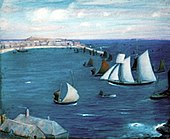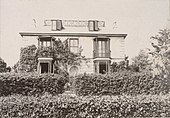Thomas Millie Dow
Thomas Millie Dow (born October 28, 1848 in Dysart , Fife , Scotland , † July 3, 1919 in St Ives , Cornwall , England ) was a Scottish painter of Late Impressionism and an important representative of the Glasgow Boys , a group of artists from the 19th and early 20th century.
life and work
Thomas Millie Dow, born in Dysart, Fife, Scotland, in 1848, received a legal education as he was expected to follow his father and brother into the family law firm in Kirkcaldy . However, Dow decided against a legal career and went to Paris in 1877 to study painting . He first enrolled at the École nationale supérieure des Beaux-Arts with Jean-Léon Gérôme . In 1879 he learned at the Académie Julian and in the studio of Émile Auguste Carolus-Duran .
Among the many young British and American students who went to Paris to study art in the late 1870s were two men who became close friends of Dow: the Englishman William Stott and the American Abbott Thayer . Both men would have had a significant impact on Dow's artistic work. In Paris, Dow also made friends with the Glasgow artists James Paterson , Alexander Mann , John Lavery and Alexander Roche .
Between 1877 and 1879 Dow spent the winters in Paris and went on painting excursions to Barbizon , Grez-sur-Loing and Fontainebleau with his fellow students Mann and Paterson . He spent the summers painting and drawing on the east coast of Scotland, often staying in Stonehaven and Cullen . In 1878 he exhibited for the first time at the Royal Scottish Academy in Edinburgh and in 1879 at the Royal Glasgow Institute of the Fine Arts . During this time Dow painted mainly with watercolor and pastel colors , but also with oil colors .
In September 1883 Dow sailed on the Devonia from Glasgow to New York and from there traveled up the Hudson River to Cornwall-on-Hudson, where his friend Abbott Thayer lived with his wife Kate Bloede. Dow remained in the United States until the summer of 1884. During these months he created excellent landscape paintings, including The Hudson River , now in the Kelvingrove Art Gallery and Museum in Glasgow.
On his return to Glasgow, Dow joined the Glasgow Boys , an artist group led by William York MacGregor , who made Impressionism and Post-Impressionism known in Scotland through their work . Dow used MacGregor's Glasgow studio during this time and shared the apartment with Allan McLean, a lawyer and art collector. In 1885 Dow became a member of the Royal Scottish Society of Painters in Watercolor .
Between 1885 and 1887 traveled Dow often from Glasgow to Moniaive in the county of Dumfriesshire , where earlier James Paterson had stopped. It was there that Dow painted his first allegories . During this time the painting The Spring was created . He established himself as a recognized artist and was able to present his works in London at the Grosvenor Gallery and the Grafton Gallery . This was soon followed by exhibitions at the Vienna Secession , in Munich and Berlin , and later also in major cities in the United States.
In 1887 Dow was accepted into the Glasgow Art Club and the New English Art Club , where he regularly showed his work until 1891. In 1888 Dow spent the summer in the mountains of Switzerland and Germany . There he also painted for some time with his friend William Stott. Works like Moonlight In The Alps were created . In the spring of 1889 he traveled to Morocco , where he created some well-known pastel pictures.
In 1891 Dow married the widowed Florence Pilcher, b. Cox. Florence brought a boy and a girl into the marriage. In 1892 their daughter Mary Rosamond was born. In 1894 the family moved from Glasgow to St Ives in the southwestern county of Cornwall . There Dow joined his friends and fellow painters Louis Grier and Lowell Dyer as members of the St Ives Arts Club . Although Dow lived a long way from Glasgow, he was so well known that his paintings were regularly shown in Glasgow and the surrounding cities.
In 1895 he bought Talland House in St Ives from Leslie Stephen , father of Virginia Woolf .
From 1896 Dow spent the winter months in Italy with his family . There he created numerous watercolors and pastel pictures of valleys and villages in the Apennines and areas of Veneto . In addition, he continued to paint allegorical scenes such as The Kelpie , which is now lost and only preserved as a photographic reproduction. His most frequent theme in both oil and pastel was the port of St Ives and the Cornish countryside. In 1898 Dow became a member of the Pastel Society and the Royal Institute of Oil Painters .
Dow died in St Ives in 1919 and was buried in the neighboring town of Zennor .
Web links
Individual evidence
- ↑ Thomas Millie Dow , cornwallartists.org
| personal data | |
|---|---|
| SURNAME | Dow, Thomas Millie |
| BRIEF DESCRIPTION | Scottish late impressionism painter |
| DATE OF BIRTH | October 28, 1848 |
| PLACE OF BIRTH | Dysart , Fife |
| DATE OF DEATH | July 3, 1919 |
| Place of death | St Ives , Cornwall |





